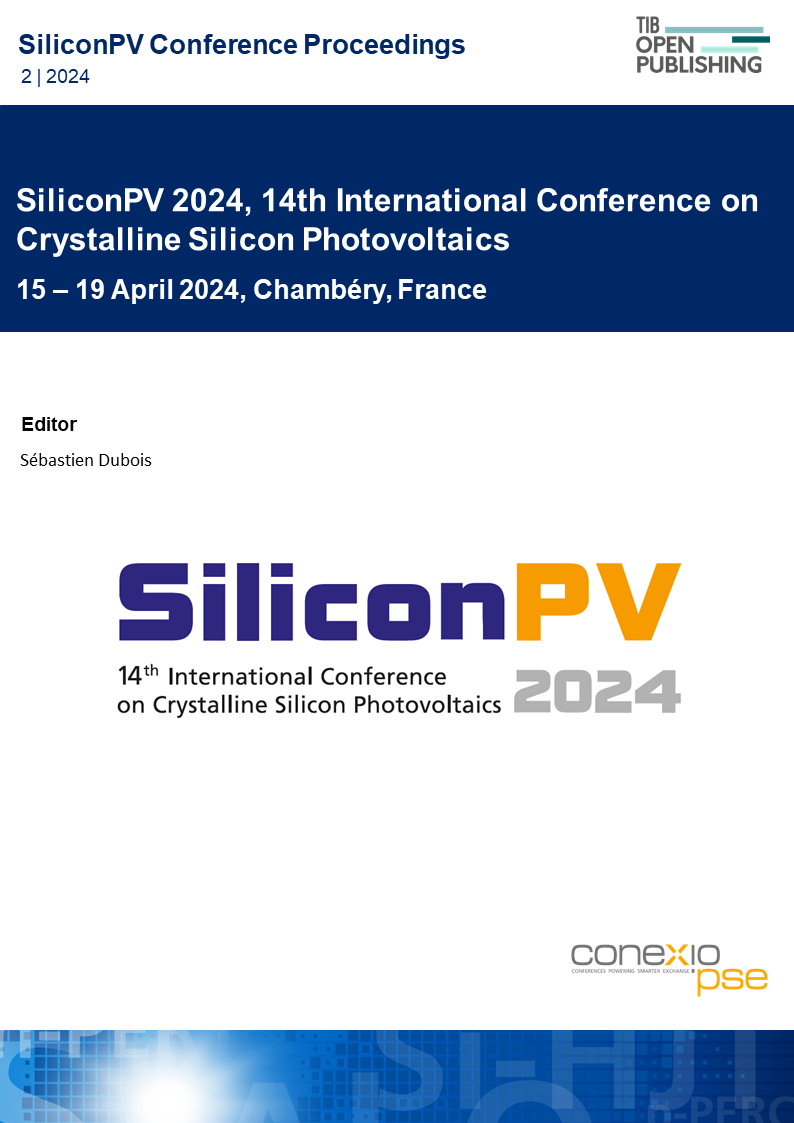Deep-Learning Based Depth-Tracking of Stacking-Faults in Epitaxially Grown Silicon Wafers
DOI:
https://doi.org/10.52825/siliconpv.v2i.1265Keywords:
Kerfless Silicon Growth, Stacking Faults, Image Segmentation, Quality InspectionAbstract
Stacking faults in epitaxial silicon wafers are structural defects that can reduce the recombination lifetime of the final solar cells significantly. They are known to originate mostly at the interface between substrate and deposited layer, at contamination particles and atomic steps. This work presents a non-destructive and automated characterization method on full-size wafers to locate stacking faults and determine their layer of origin to identify process-based root causes. A deep learning model and a quantification via geometric defect properties is realized on dark field microscope images, with the potential to be transferred to inline images measured in dark field mode with high-resolution cameras. We achieve detection rates up to 92% for regular wafer surfaces. The depth analysis combines geometric properties of the stacking faults and measured wafer thickness and is applied on full-scale epitaxial wafers. Most stacking faults are confirmed to originate at the interface layer and their number is higher by 1-2 orders of magnitude when deposition occurs on a reorganized porous layer. However, our results also indicate that a non-negligible part of stacking faults has its origin within the epitaxial layer.
Downloads
References
[1] M. Iwabuchi, K. Mizushima, M. Mizuno, and Y. Kitagawara, "Dependence of Epitaxial Layer Defect Morphology on Substrate Particle Contamination of Si Epitaxial Wafer," Journal of The Electrochemical Society, vol. 147, no. 3, p. 1199, 2000, doi: 10.1149/1.1393336.
[2] M. Kivambe, "Characterization of high-quality kerfless epitaxial silicon for solar cells: De-fect sources and impact on minority-carrier lifetime," Journal of Crystal Growth, no. 483, pp. 54–64, 2018, doi: 10.1016/j.jcrysgro.2017.11.016.
[3] S. Janz et al., "Origin and Impact of Crystallographic Defects in Epitaxially Grown Si Wa-fers," 2017, doi: 10.4229/EUPVSEC20172017-2BO.3.6.
[4] O. Ronneberger, P. Fischer, and T. Brox, "U-Net: Convolutional Networks for Biomedical Image Segmentation," in Medical Image Computing and Computer-Assisted Intervention ‐ MICCAI 2015, 2015, pp. 234–241, doi: 10.1007/978-3-319-24574-4_28.
[5] P. Rudolph, "Defect Formation During Crystal Growth from the Melt," in Springer Hand-book of Crystal Growth, G. Dhanaraj, K. Byrappa, V. Prasad, and M. Dudley, Eds.: Springer Berlin Heidelberg, 2010, pp. 159–, doi: 10.1007/978-3-540-74761-1_6.
Published
How to Cite
Conference Proceedings Volume
Section
License
Copyright (c) 2024 Theresa Trötschler, Saed Al-Hajjawi, Siddharth Raghavendran, Jonas Haunschild, Matthias Demant, Stefan Rein

This work is licensed under a Creative Commons Attribution 4.0 International License.
Accepted 2024-11-27
Published 2025-02-03
Funding data
-
Bundesministerium für Wirtschaft und Klimaschutz
Grant numbers 03EE1043C
